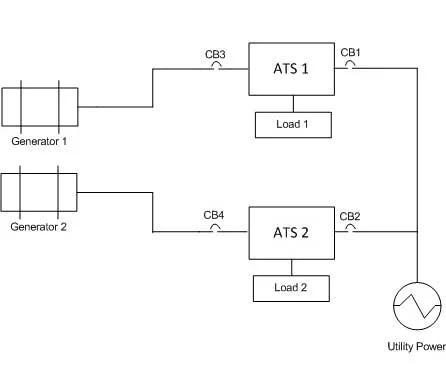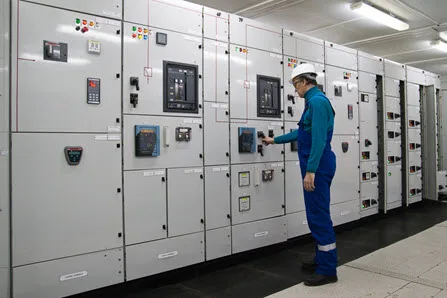In industrial settings, emergency power systems often rely on complex power generation and distribution setups. This includes generators, Automatic Transfer Switches (ATS), switchgear, and other electrical components. While both ATS and switchgear are essential for efficient power distribution, they serve distinct roles. Below is an explanation of their differences and applications.
Automatic Transfer Switch (ATS)
Definition and Function
An Automatic Transfer Switch (ATS) is a device that automatically transfers a facility’s electrical load from the utility power to a backup power source (usually a generator) in the event of a power outage. Once utility power is restored, the ATS switches back to the utility and shuts down the generator.

Key Characteristics of ATS:
- Automatic Switching: The ATS detects a loss of utility power and initiates the startup of the generator. Once the generator is ready, the ATS transfers the load to the generator.
- Single Generator Configuration: In smaller systems, a single generator may be used to supply emergency power. The ATS ensures the generator is activated when needed and switches back to the utility when power is restored.
- Multiple Generator Configuration: Larger sites with multiple buildings or extensive systems may use multiple generators. Each building or area has its own ATS to manage its power supply independently. In these configurations, the ATS ensures that only the affected building’s generator is started when utility power fails.
- Emergency Power Supply: ATS is typically used to provide emergency, prime, or continuous power to critical systems like lighting, ventilation, or communication during utility failures.
- Reseller Options: As an ASCO Reseller, Generator Source offers a variety of ATS products, with technical details and resources available for customers.
Switchgear
Definition and Function
Switchgear is a collection of electrical components used to control, protect, and isolate electrical circuits and equipment. It is typically used for high-voltage systems and provides both manual and automatic switching capabilities. Switchgear can range from simple residential circuit breakers to complex, custom-designed systems for industrial applications.
Key Characteristics of Switchgear:

- Low to High Voltage Systems: Switchgear can be found in both low- and high-voltage systems. It includes circuit breakers, fuses, and disconnect switches, which protect circuits from overloads and short circuits.
- Circuit Protection and Distribution: Switchgear is used to protect equipment and manage power distribution within a facility. In residential applications, a circuit breaker panel acts as basic switchgear, where an ATS supplies power when the utility fails.
- Advanced Industrial Switchgear: For industries with critical power needs (e.g., hospitals, data centers), switchgear can be highly advanced and custom-designed. These systems can manage multiple generators and provide automatic load balancing and power distribution to vital circuits.
- Paralleling of Generators: In complex systems, switchgear and generator control software allow for the automatic paralleling of multiple generators during a power loss. This enables the facility to maintain a stable power supply even during major outages.
- Control Room Integration: For large facilities, switchgear is often integrated into a central control room, which manages the operation of generators, ATS, and power distribution panels.
Comparison of ATS and Switchgear
| Feature | Automatic Transfer Switch (ATS) | Switchgear |
|---|---|---|
| Function | Automatically transfers load to generator during power failure and back to utility power when restored. | Controls, protects, and isolates electrical circuits, used in both manual and automatic switching. |
| Application | Provides emergency or continuous power to essential loads during outages. | Distributes power, protects circuits, and manages power systems across a facility. |
| Complexity | Generally simpler and focused on switching between utility power and generator power. | Can be very complex, especially in large facilities with high voltage requirements and multiple generators. |
| Generator Interaction | Commands generator startup and load switching during power failures. | Allows for paralleling of generators and distribution of power to critical systems. |
| Use in Residential Settings | Often used in homes for backup power systems. | Basic switchgear (e.g., circuit breaker panel) can be found in homes. |
| Use in Industrial Settings | Manages the transition to generator power when utility fails. | Used for high-voltage applications, control rooms, and critical infrastructure with more complex power needs. |

Conclusion
While ATS and switchgear are both integral parts of industrial and commercial power systems, they serve different functions. The ATS ensures a smooth transition to backup power when utility power is lost, making it essential for critical operations. On the other hand, switchgear is used for controlling and protecting electrical circuits, often in more complex and high-voltage systems.
In larger and more advanced systems, both ATS and switchgear work together to ensure uninterrupted power distribution and safety. Understanding the specific needs of a facility will help determine the appropriate combination of ATS and switchgear components for optimal performance.